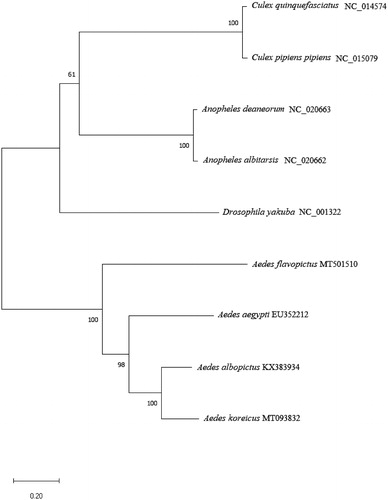Abstract
In this study, we determined for the first time the mitochondrial genome sequence of an Aedes flavopictus specimen collected in South Korea. Its mitochondrial genome was 16,060 bp in length, consisting of 13 protein-coding, 22 tRNA, and 2 rRNA genes and a non-coding A + T rich region. The overall base composition in the heavy strand was 39.7, 8.6, 12.7, and 39% of A, G, C, and T, respectively, and the G + C content was 21.2%. Phylogenetic analysis revealed that Aedes spp. formed a monophyletic clade.
Mosquitoes belonging to the genus Aedes are responsible for transmitting fatal human diseases (Alphey et al. Citation2013). For example, Aedes albopictus and Aedes aegypti can carry and spread the Zika and yellow fever viruses (Lambrechts et al. Citation2010). Aedes flavopictus is widely distributed in East Asia, including Korea and Japan, belonging to the same genus as A. albopictus and Aedes koreicus (Tanaka Citation1979; Shin and Jung Citation2020). This particular mosquito had never been found in countries other than Korea and Japan until 2019, when it was identified in the Netherlands and a new invasion of Europe was confirmed (Doggett et al. Citation2019; Ibáñez-Justicia et al. Citation2019). No other vector is known to have the same characteristic as A. albopictus and other Aedes species; however, A. flavopictus has previously shown the potential to transmit dengue fever in laboratory conditions (Toma et al. Citation2002; Srisawat et al. Citation2016). In this study, the mitochondrial genome sequence of A. flavopictus (GenBank accession number: MT501510) was confirmed.
We collected an A. flavopictus specimen from Bonghwa-gun, South Korea (geographic location: 36°47′05.0′′N 128°56′32.6′′E) in June 2017. The specimen was preserved in 80% ethanol and stored at the Ewha Womans University Natural History Museum of Korea (accession number: EWNHM-DONATION-IN-2). The mtDNA was sequenced using Novaseq 6000 System (Illumina, San Diego, CA, USA); the MITObim method (Hahn et al. Citation2013) and MITOS (Bernt et al. Citation2013) were used for the assembly and annotation of the complete mitochondrial genome, respectively.
The mitogenome of A. flavopictus was 16,060 bp in length and consisted of 13 protein-coding, 22 tRNA, and 2 rRNA genes and a non-coding A + T-rich control region. For the 13 protein-coding genes, the most common shared start codon was ATG (in COX2, ATP6, COX3, ND4L, ND4, and CYB), followed by ATT (in ND2, ND3, ND6, and ATP8). The most common termination codon was TAA (in ND2, ATP8, ATP6, COX3, ND3, ND5, ND4, ND4L, ND6, CYTB, and ND1), followed by the incomplete termination codon T− (in COX1 and COX2). The overall mitochondrial base composition of this genome was A: 39.7%, T: 39%, G: 8.6%, and C: 12.7%, with a G + C content of 21.2%.
To investigate whether A. flavopictus was genetically similar to other viral vector mosquitoes that carry the Zika and dengue fever viruses, its phylogenetic position within the family Culicidae was investigated using the complete mitochondrial genome sequence of nine species (). The phylogenetic trees were constructed by MEGA X (Kumar et al. Citation2018) using the neighbor-joining algorithm with 1000 replicates. The results revealed that Aedes spp. formed a monophyletic group.
Figure 1. Phylogenetic tree of nine species within Culicidae constructed using the neighbor-joining algorithm based on complete mosquito mitochondrial genomes. Genbank Accession Numbers: Aedes flavopictus (MT501510), Aedes koreicus (MT093832), Aedes albopictus (KX383934), Aedes Aegypti (EU352212), Anopheles albitarsis (NC_020662), Anopheles deaneorum (NC_020663), Culex pipiens pipiens (NC_015079), Culex quinquefasciatus (NC_014574), and Drosophila yakuba (NC_001322).

These findings provide novel genetic insights into the members of the genus Aedes that could be relevant to better understand these vectors known to be responsible for spreading several deadly human diseases.
Disclosure statement
No potential competing interest was reported by the author(s).
Data availability statement
The data that support the findings of this study are openly available in Mendeley Data at http://dx.doi.org/10.17632/b2mfmmdhnx.1
Additional information
Funding
References
- Alphey L, McKemey A, Nimmo D, Neira Oviedo M, Lacroix R, Matzen K, Beech C. 2013. Genetic control of Aedes mosquitoes. Pathog Glob Health. 107(4):170–179.
- Bernt M, Donath A, Jühling F, Externbrink F, Florentz C, Fritzsch G, Pütz J, Middendorf M, Stadler PF. 2013. MITOS: improved de novo metazoan mitochondrial genome annotation. Mol Phylogenet Evol. 69(2):313–319.
- Doggett S, Clancy J, Toi CS, Haniotis J, Russell RC, Hueston L, Marchetti M, Dwyer DE, Mcintyre L, Goodwin J, et al. 2019. The New South Wales Arbovirus Surveillance and Mosquito Monitoring Program. New South Wales (Australia): NSW Health. (2018–2019 Annual Report).
- Hahn C, Bachmann L, Chevreux B. 2013. Reconstructing mitochondrial genomes directly from genomic next-generation sequencing reads—a baiting and iterative mapping approach. Nucleic Acids Res. 41(13):e129.
- Ibáñez-Justicia A, van de Vossenberg B, van den Biggelaar R, Voogd J, Metz E, Jacobs F, Dik M, Stroo A. 2019. Detection of Aedes flavopictus (Yamada, 1921), Netherlands, June 2019. Eurosurveillance. 24(30):1900433.
- Kumar S, Stecher G, Li M, Knyaz C, Tamura K. 2018. MEGA X: Molecular Evolutionary Genetics Analysis across computing platforms. Mol Biol Evol. 35(6):1547–1549.
- Lambrechts L, Scott TW, Gubler DJ. 2010. Consequences of the expanding global distribution of Aedes albopictus for dengue virus transmission. PLoS Negl Trop Dis. 4(5):e646.
- Shin J, Jung J. 2020. First record of the complete mitochondrial genome of Aedes koreicus (Edwards, 1917) (Diptera: Culicidae) in South Korea. Mitochondrial DNA Part B. 5(2):2000–2001.
- Srisawat R, Phanitchat T, Komalamisra N, Tamori N, Runtuwene L, Noguchi K, Hayashida K, Hidano S, Kamiyama N, Takashima I, et al. 2016. Susceptibility of Aedes flavopictus miyarai and Aedes galloisi mosquito species in Japan to dengue type 2 virus. Asian Pacific J Trop Biomed. 6(5):446–450.
- Tanaka K. 1979. A revision of the adult and larval mosquitoes of Japan (including Ryukyu Archipelago and the Ogasawara Islands) and Korea (Diptera: Culicidae). Contrib Am Entomol Inst. 16:1–987.
- Toma T, Miyagi I, Crabtree MB, Miller BR. 2002. Investigation of the Aedes (Stegomyia) flavopictus complex (Diptera: Culicidae) in Japan by sequence analysis of the internal transcribed spacers of ribosomal DNA. J Med Entomol. 39(3):461–468.
